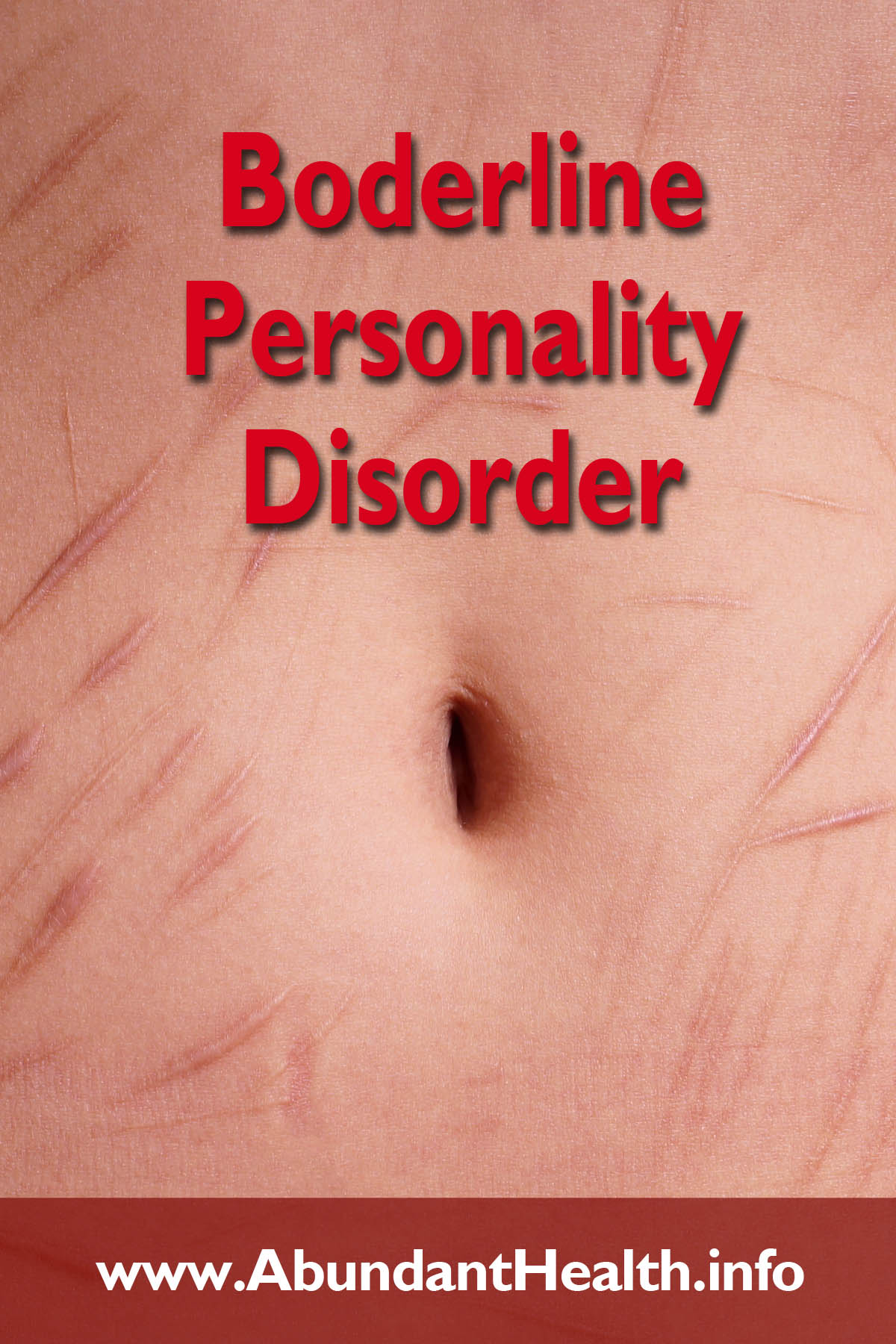Borderline personality disorder is a serious personality disorder characterized by emotional dysregulation, extreme thinking and chaotic relationships. Those suffering from this mental disorder have various psychiatric symptoms, such as unstable and reactive moods, identity problems, feelings of irreality and depersonalization. There is a tendency towards impulsive and, especially, self-destructive behavior, manipulation, blackmail, suicidal behavior, and chronic feelings of emptiness and boredom.

These people act unpredictably, without worrying about the consequences of their actions, and tend to have bouts of anger. They are often thought of as rebellious, problematic, ingenious and temperamental, but in reality they have a deeper mental disorder than those who just have a difficult temperament. There is an individual with an impulsive personality, in which there is emotional instability and a lack of emotional control, and the borderline type itself, whose characteristics go beyond uncontrolled impulses. The person has an altered self-image, intense and unstable relationships, self-destructive behavior and difficulty creating life goals.
The word borderline comes from the English word for boundary, the demarcation line of a border. The line that separates one area from another. This term was used by Adolph Stern, who in the 1930s described a condition as one that remains on the borderline between neurosis and psychosis.
Borderline personality disorder seriously affects the whole life of the person suffering from it, causing significant damage both to themselves and to other people. These people often need psychotropic medication, such as antidepressants or mood modulators, to avoid intense emotional distress. Symptoms appear more in late adolescence and become more pronounced in early adulthood, usually persisting throughout life unless appropriate interventions are put in place.
The severity of the disorder often diminishes over time. Involvement with drugs, attempted suicide, completed suicide, are all possible outcomes if the person does not undergo proper care and psychiatric and psychological therapy.
The cause of borderline personality disorder is related to a sum of factors, including a traumatic childhood with various forms of abuse in the family of origin, separation from parents, sexual and emotional abuse, as well as a genetic predisposition and alterations or dysfunctions in brain metabolism. On average, 2% of the population suffers from this disorder, 76% of whom are women and 20% of the prison population.
Around 80% of patients with borderline personality disorder report that their parents’ marriage was or is very dysfunctional, with many conflicts. Many patients with this disorder experience neglect, or have experienced it in their past, or continue to experience neglect and physical or sexual abuse within their family of origin, but despite this, around 20 to 25% of people with borderline disorder come from structured families, with no major complications in their families.

To make an initial assessment as to whether or not the person has this type of disorder, it is important for the doctor to order blood tests to measure TSH levels, to rule out the possibility of a thyroid problem, and a serum calcium test to rule out a possible metabolic disease. A complete blood count is important to check for any systemic infections that could be contributing to the symptoms. Serology to rule out syphilis or HIV infection is also important, as these diseases can affect areas of the brain. In addition, neurological tests such as electroencephalography, computed tomography and magnetic resonance imaging are important to check for brain damage.
Symptoms of Borderline Disorder
Affective Symptoms
The borderliner has marked affective instability due to intense mood reactions. Then they have episodes of dysphoria. Dysphoria is when the person is screaming at one time, and at another time wants total isolation, is very euphoric at one moment, then irritable. They are anxious for a few hours and rarely, at most, for a few days. The person with this disorder also has a lot of anger, hatred and inappropriate rage, which is intense and difficult to control. For example, they show frequent displays of irritation, constant anger, a sense of revenge and sometimes they fight a lot, in the sense of even physical violence towards others.
There is also the borderliner, who has chronic feelings of emptiness and boredom in their life. Now, thinking in terms of symptoms linked to impulsivity, they have recurrent suicide attempts or threats and self-mutilation behavior, which is something that is quite common, almost epidemic, among young people; self-mutilation – self-harm, cutting the skin – this happens in this type of personality disorder too.
The individual will have a pattern of very unstable, very intense interpersonal relationships, characterized by extremes of idealization: one moment that person is the queen of my life, the king of my life, and the next, a moment of devaluation, they’re useless, I don’t want them, it’s better to die; feelings of love and hate, good or bad. There is impulsivity, at least in some areas of this person’s life that are harmful to them. For example, they get involved in excessive financial spending, risky sexual behavior, drugs, alcohol, reckless driving and various kinds of compulsions.

Interpersonal Symptoms
Now, let’s think about symptoms that occur in the relationship between a person with a borderline disorder and other people they live with. Firstly, they desperately try to avoid abandonment, real or imagined rejection. They have an unstable identity and self-image. Sexual preference fluctuates a lot; tastes and values are very and persistently unstable. Moods fluctuate constantly.
As cognitive symptoms in this person with this disorder, they start to have transient paranoid ideas related to the stress they are experiencing. What is a paranoid idea? They are ideas or suspicions of persecution: “they’re talking about me”, “there’s someone who’s going to disturb me”, and they may have symptoms of dissociation.
Psychopaths, which is an old term for a personality disorder, usually manipulate in order to obtain material or financial goods or things that give them pleasure, while people with borderline disorder manipulate and commit extreme acts in order to obtain support and affection.
These people suffering from borderline personality disorder end up pushing away those they need most. Paradoxically, at the same time as they need affection and companionship, they are capable of pushing them away in cruel and often frightening ways. They are very needy of attention and excessively manipulative, although they never admit it.
Borderlines have deep traits of masochism, of sadism; in general, they are like children in an adult body, not tolerating any limits. They are very emotionally immature, impatient, don’t know how to wait, their rewards must always be pediatric, they can’t tolerate frustration and always tend to blame others for their own failings. This is probably because borderlines have usually been children deprived of a basic need, possibly emotionally neglected at some stage in their psychic life, which in turn has caused deep and indelible marks on their personality. These marks can come from numerous traumatic events, such as parental separation, childhood sexual abuse, physical violence and even the early loss of a loved one.
So, based on this assumption, we can say that the emotional development of the person with borderline disorder has stalled dramatically before reaching the stage of full psychological maturation. In short, they are people who grow and age physically, but emotionally remain selfish and, unfortunately, very problematic children. Borderline individuals can be people who have grown up with a great sense of not having received enough attention, and generally act like angry children, seeking ways to make up for this lack of attention in their relationships; complicated ways that are immature and abnormal.
How to Change?
There are people who are difficult to live with, such as the obsessives, the emotional, the detail-oriented, the perfectionists, the inflexible, the rigid, among others. It’s not uncommon for some people to say, “Wow, what a neurotic person!” when dealing with such complicated individuals. Well, they’re like that because of some mental illness, or they’re like that because they grew up with one or more of these characteristics, which we’ve presented, of being detail-oriented, perfectionists and tragics. We know that there is a space in our mind called the unconscious, a virtual space that leads us to do or say things that can scare us. But the question also arises: do I have an unconscious mind, or am I unconscious? People can be changed, but they can also settle into their way of being and remain the same until they die.
An important questions in this regard might be: Do I want to change? Do I realize that my behavior is something that makes me suffer and makes other people suffer? Do I want to improve my personality traits, which are immature and complicated and cause suffering in the people I live with? It’s very difficult to live with people who answer such questions with arguments like: “That’s the way I am, and that’s the way I have been; it’s worked out well for me so far, why should I change?” Or others say: “I don’t have any difficulties with the way I am, it’s the other people who criticize me.” But the truth is that there is no person who doesn’t need to improve their personality. Emotional maturity is a lifelong goal.

Difficult people can change, but they need to want to change themselves because they have stopped denying that they have personality problems. Stopping denying is the first big step towards starting to change. To stop denying is to admit the existence of the problem, and this in turn is basic, and fundamental to finding ways of resolving it.
It’s not easy to change who we are, I admit that; it’s a struggle. We often get complacent and stagnate in the way we are; we want to stay in the comfort zone of our lives, to stay that way because it has worked so far. But if you realize your personal problems, your personality and cultivate the desire to improve who you are, if you work hard enough, some change will occur in your way of being. This is the opposite of remaining stuck in a rigid way of being, of existing as a person causing suffering in others, as well as self-suffering, because the person ends up running away from the truth about themselves, and lives in suffering that they do not need to experience.
In fact, many people have what we scientifically call a personality disorder. They have a very unhealthy ego, above the limitations that we all have in our personality. For some authors, these people are individuals with an abnormal personality, without, however, having a brain injury. It’s a way of being with a very strong tendency to remain that way all their lives, compromising their relationship skills in general. The personality disorder appears early in the person’s development and becomes strongly ingrained in them, making them the way they are.
Thought Patterns
Do you want to know some of the types of thoughts that people with borderline personality disorder have? Some say: “I have to be loved by all the important people in my life all the time, otherwise it means I’m worthless.” You can see how extreme it is, can’t you? Others say: “Some people are great and everything about them is perfect. Other people are completely awful and should be severely censored and punished for it.” It’s a radical way of thinking that these people have.
Another individual with borderline disorder might reason like this: “I hate it when people don’t pay attention to me.” Or they might say: “I have no control over my feelings or the things I do as a result of them.” You want to wash your hands of it, right? Others think: “When I’m alone, I become nobody and nothing.” How radical is that? Still others might think: “I can’t stop the frustration I feel when I need something from someone and I’m not able to receive it.” What do you mean you can’t stop walking around in frustration? But they live it. And others may have this thought: “What have I done to make this person look down on me?” The person may not be looking down on them, but the borderliner interprets it that way.
If someone with a personality disorder makes an effort to analyze their unhealthy tendency to think, feel and relate to others, it will be possible to relax the rigidity of their altered personality trait. This will reduce the suffering for themselves and the people they live with. Then they will learn, when they do this self-analysis, when they are honest with themselves, when they stop denying and admit that they have problems with the way they think and the way they live with people, that they can learn to control aggressive, explosive impulses and discipline their serious distorted thoughts. They will see that they hold unhealthy psychological beliefs about situations in life and relationships. They will be able to reduce unhealthy jealousy by learning that it generates a lot of quarrels. They will be able to be more merciful to themselves and other people regarding spending and other things.
So, when someone with a personality disorder decides to do what they can to improve their behavior, they can get out of this unhealthy state of being and, step by step, become more pleasant, reliable, flexible, affectionate, less dramatic, less hysterical, less aggressive and explosive, less cold and calculating, starting to have just a few traits, perhaps not dominant, of what was previously very rigid and deeply ingrained in their personality.

How do you treat a person with a borderline disorder?
There is medication. Various medications can be used for people with borderline personality disorder. Since this disorder is considered to be primarily a psychosocial condition, medication is indicated to treat what they experience, such as anxiety symptoms or depressive symptoms, rather than behavioral changes. Psychotherapy is another basic tool to help people with borderline personality disorder, so that they can learn, through psychoeducation, to better control their impulses, to better understand their behavior. In psychological therapy, they can learn skills they don’t have, such as becoming aware of their distorted thoughts, improving their relationships with people and dealing with frustrations. To learn this, psychotherapy will generally help the person with this disorder to:
- Admitting that he has a problem.
- Seek and receive help to change, and be actively involved.
- Understand and realize that there are distorted thinking patterns in his mind, based on erroneous beliefs that he has developed throughout his life.
- Cultivate the concept that you need to accept that perfection is a goal that we can never fully achieve. Accepting this can reduce anxiety, as well as aggression, emotional outbursts and hostility, which hinder pleasant contact with people.
- Look at the mistakes you’ve made unintentionally as moments to learn from, rather than belittling and distressing yourself.
- Allow yourself to have moments of relaxation, leisure, enjoying something pleasant, and appreciating friendships.
I wish that God would give us all a clear mind to better understand ourselves and those around us. If you live with someone with borderline disorder, it’s important that you are knowledgeable so that you can learn to set limits. If you are the one with borderline disorder, then you have learned here today some steps to get out of it or to minimize and improve it step by step.

Stay Always Up to Date
Sign up to our newsletter and stay always informed with news and tips around your health.

Dr. Cesar Vasconcellos de Souza is working as a psychiatrist and international speaker. He is author of 3 books, columnist of the health magazine “Vida e Saúde” for 25 years, and has a regular program on the “Novo Tempo” TV channel.
Leave a Reply